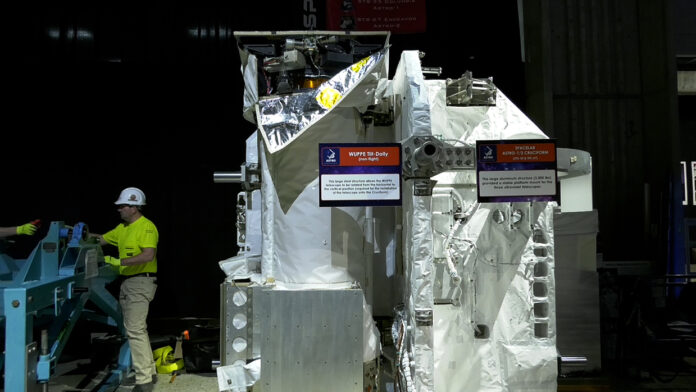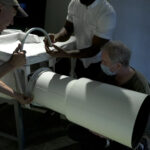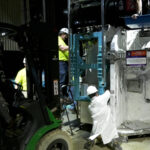Yes, much like old cars abandoned in a junkyard where only sentimental mechanics go to strip them of reusable parts, so go once magnificent pieces of spaceflight hardware to the scrapyard of forgotten missions.
But there was a happy ending Tuesday for two pieces of discarded hardware salvaged from such a scrapheap by a group of volunteer engineers who worked on the initial two Spacelab astrophysics missions called the Astro missions that flew aboard the space shuttle in the 1990s.
Known as the Astro Restoration Project, the fully restored Astro cruciform was reunited with one of its four counterpart telescopes in a formal presentation at the Space & Rocket Center Tuesday.
“Today marks an important milestone in the restoration of Astro-1,” said Dr. Kay Taylor, vice president of Education at the U.S. Space & Rocket Center. “Today we rejoin the first of the telescopes, the Wisconsin Ultraviolet Photo Polarimeter Experiment (or WUPPE for short) telescope.
“This instrument was the first to capture and polarize light in order to measure the magnitude of magnetic fields surrounding stars.”
Astro’s other two telescopes, the Hopkins Ultraviolet Telescope (HUT) and Goddard Space Flight Center’s Ultraviolet Imaging Telescope (UIT) will be mounted on the cruciform later this year.
Several entities joined the volunteer efforts such as Teledyne Brown Engineering who provided technical support for the project, the U.S. Space & Rocket Center who provided the physical space to complete it, and several other entities including both NASA at Marshall Space Flight Center here in Huntsville, and NASA at Kennedy Space Center in Florida.
Byron Bonds, liaison engineer for Astro missions at Teledyne Engineering said, “Astro’s original missions were astronomical science contributions to the world.
“Astro’s future contribution, its next mission, is to inspire STEM among students as you see HUNCH participating here today.”
HUNCH (High School Students United with NASA to Create Hardware) is a NASA program that involves high school students in fabricating prototype and flight-like hardware.
The Astro missions are important because more than 120 scientific papers were written from the Astro-1 observations, and more than 150 technical papers were published in astronomy journals from data gathered during the Astro-2 mission.
The telescopes returned unique information about hot stars, nebulae, remnants of supernovas, and interstellar gas and dust in the Milky Way. They also observed stars in other galaxies.
Watch a short video about the Astro Restoration Project.
Don’t miss out! Subscribe to our email newsletter to have all our smart stories delivered to your inbox.






